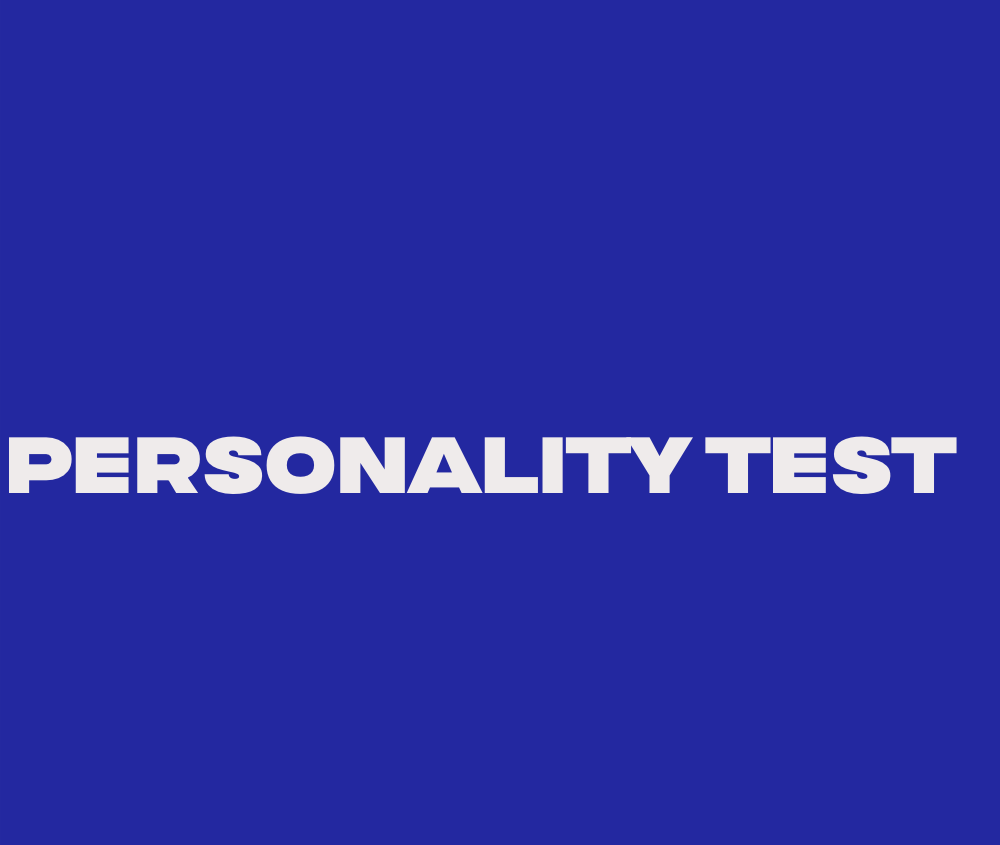Personality Exploration
DOPE Personality Test Explained: Traits & Types

Did you know that there is a personality test that simplifies complex human behaviors into four distinct bird types? Meet the DOPE personality test, a fun and insightful way to understand different personality traits and preferences. Unlike other tests that use numbers or intricate categories, the DOPE test categorizes individuals as Doves, Owls, Peacocks, or Eagles, based on their unique characteristics.
Are you intrigued to learn more about the DOPE personality test and discover what bird type represents your personality? Join us as we dive into the world of the DOPE test and explore the traits and types associated with each bird category.
- The DOPE personality test simplifies personalities into four types represented by birds.
- Doves are friendly and loyal individuals who excel in creating harmony.
- Owls are logical and analytical, thriving in structured environments.
- Peacocks are vibrant and social, bringing innovation and optimism to the table.
- Eagles are confident leaders who thrive on challenges and results.
- Understanding your bird type can enhance self-awareness and improve interpersonal relationships.
The Dove: The Peacemaker
Doves are the friendly and loyal type of individuals. They prefer calm and predictable environments and have an innate desire to be helpful. Doves are great team players and focus on creating harmony and building strong relationships. They excel in roles that require empathy and patience, such as creative fields, human resources, and community engagement.
As peacemakers, Doves bring a sense of calm and stability to their surroundings. They value cooperation and strive to maintain a peaceful and harmonious atmosphere. Their nurturing and supportive nature makes them an asset in team settings, where they excel at mediating conflicts and promoting collaboration.
Characteristics of a Dove:
- Friendliness and loyalty
- Preference for calm and predictable environments
- Desire to be helpful
- Strong focus on creating harmony
- Ability to build strong relationships
- Empathy and patience
With their empathetic nature, Doves excel in roles that require understanding and compassion. They are often drawn to creative fields, where they can use their nurturing qualities to inspire and bring out the best in others. In human resources, Doves shine in fostering positive work environments and resolving conflicts through diplomacy and empathy. Their ability to connect with others on an emotional level also makes them well-suited for community engagement roles, helping to build bridges and create positive change.
When working alongside Doves, it’s important to recognize and appreciate their strengths. They thrive in environments that value collaboration, open communication, and emotional well-being. By leveraging their natural abilities and creating a supportive atmosphere, teams can benefit from the unique contributions of Doves.

Image:
The Owl: The Wise Wizard
Owls are logical and methodical individuals who excel in analytical tasks. With a strong attention to detail, they are often seen as perfectionists. Owls are great at problem-solving and prefer structured environments that allow them to analyze and dissect information. Their ability to think critically and assess situations from multiple angles makes them invaluable assets in various fields.
The Characteristics of an Owl
Owls possess several key characteristics that define their personality type:
- Analytical: Owls have a natural inclination toward analysis and enjoy breaking down complex problems into manageable components.
- Detail-oriented: They have a keen eye for detail and strive for precision in their work.
- Logical: Owls rely on logic and evidence when making decisions and prefer objective reasoning over emotional factors.
- Structured: They thrive in structured environments that provide clear guidelines and well-defined systems.
- Introspective: Owls are introspective individuals who value self-reflection and enjoy exploring complex ideas and concepts.
These characteristics make Owls well-suited for roles that require meticulous attention to detail and a high level of analytical thinking. Occupations such as accounting, software engineering, research, and strategic planning align well with the strengths of Owls.
“The owl can see things that others cannot, and its wise counsel guides us toward insight and understanding.”
A Day in the Life of an Owl
Let’s take a closer look at a typical day in the life of an Owl:
Time Activity Morning Start the day by reviewing the previous day’s work and creating a to-do list, prioritizing tasks based on deadlines and importance. Mid-Morning Focus on research and analysis, diving deep into data and identifying patterns and trends. Afternoon Engage in problem-solving activities, collaborating with colleagues to find innovative solutions to complex challenges. Late Afternoon Take time for reflection and evaluation, reviewing the day’s accomplishments and strategizing for upcoming projects. Evening Indulge in personal hobbies and activities that stimulate the mind, such as reading, puzzles, or engaging in intellectual conversations.
By maintaining structure and focus throughout the day, Owls maximize their productivity and ensure that tasks are completed with meticulous attention to detail.

The Peacock: The Cheerleader
Peacocks are vibrant and energetic individuals who thrive in social settings. They have highly developed interpersonal skills and enjoy being the center of attention. Peacocks excel in roles that allow them to bring new ideas to life and drive innovation.
In the workplace, Peacocks are natural cheerleaders who inspire and motivate others. Their enthusiastic and optimistic nature can uplift team spirit and foster a positive work environment. Peacocks are great at building relationships and connecting with people, making them valuable assets in customer-facing roles.

Peacocks are known for their creativity and love for visual aesthetics. They have a knack for design and can add a touch of flair to their work. Whether it’s designing eye-catching marketing campaigns or creating visually appealing presentations, Peacocks have a unique ability to capture attention and make a lasting impression.
With their natural charisma and ability to engage others, Peacocks make excellent communicators. They can effectively convey ideas and persuade others to their point of view. Peacocks thrive in roles such as sales, marketing, and customer success, where their interpersonal skills and ability to connect with others are highly valued.
Peacocks are not afraid to take risks and pursue ambitious goals. They embrace change and enjoy exploring new ideas and possibilities. This adventurous spirit often leads to a fresh perspective and innovative solutions. Peacocks are well-suited for roles in product management, where they can drive innovation and bring new ideas to life.
Characteristics of a Peacock:
- Highly energetic and vibrant
- Strong interpersonal skills
- Enjoys being the center of attention
- Creative and visually-oriented
- Natural charisma and excellent communication skills
- Thrives in social and customer-facing roles
- Comfortable with taking risks and driving innovation
Peacocks play a vital role in organizations by bringing energy, creativity, and a fresh perspective to the table. Their ability to charm and engage others makes them effective communicators and natural leaders. Understanding the characteristics of a Peacock can help individuals appreciate their strengths and leverage them to thrive in their personal and professional lives.
The Eagle: The Leader
Eagles are the epitome of confidence and goal-oriented individuals. They thrive on challenges and have a natural inclination towards leadership roles. With their unwavering determination and fearlessness, Eagles are always striving for results and are not afraid to take risks.
However, the assertiveness of Eagles can sometimes cause them to lose sight of the bigger picture. In their pursuit of success, they may overlook the feelings and perspectives of others. This focus on outcomes and assertiveness can make Eagles appear strong-willed and determined, often leaving a lasting impression.
In the business world, roles that require assertiveness, strategic thinking, and the ability to motivate others are ideal for Eagles. Sales, operations management, business development, and leadership positions are all areas where Eagles can truly shine.
Characteristics of an Eagle:
- Confidence: Eagles exude self-assurance and believe in their abilities to overcome any challenge that comes their way.
- Goal-oriented: Eagles are highly focused on achieving their objectives and are driven by a strong desire to succeed.
- Leadership qualities: With their natural charisma and assertiveness, Eagles possess leadership qualities that inspire and motivate others.
- Risk-takers: Eagles are not afraid to take risks and make bold decisions in order to achieve their goals.
“The best leaders are like Eagles – they soar high, inspire others, and fearlessly navigate through challenges.”
Understanding the characteristics of an Eagle personality type can help individuals harness their strengths and overcome potential weaknesses. By embracing their natural leadership abilities and developing their interpersonal skills, Eagles can become influential leaders who drive success and growth.

Understanding the Bird Types
Each bird type within the DOPE test represents a different personality style and set of traits. Doves are peaceful and friendly, Owls are wise and logical, Peacocks are showy and optimistic, and Eagles are bold and decisive. Understanding these bird types can help individuals and managers better connect and work with others, maximizing productivity and morale in the workplace.

Doves: The Peaceful Peacemakers
In the DOPE test, Doves embody peace, empathy, and a desire for harmonious relationships. They thrive in calm and supportive environments and are known for their compassionate and caring nature. Doves excel in roles that require teamwork, conflict resolution, and emotional intelligence.
Owls: The Wise Wizards
Owls in the DOPE test demonstrate analytical thinking, attention to detail, and logical reasoning. They are highly organized and methodical individuals who excel in problem-solving and data-driven decision-making. Owls feel most fulfilled in roles that require critical thinking, research, strategy development, and complex analysis.
Peacocks: The Showy Optimists
Peacocks are flamboyant, enthusiastic, and creative individuals in the DOPE test. They bring energy, optimism, and a sense of fun wherever they go. Peacocks excel in roles that involve public speaking, creative thinking, marketing, and generating innovative ideas. Their charisma and ability to inspire others make them great team motivators.
Eagles: The Bold Leaders
Eagles are confident, driven, and assertive individuals who emerge as natural leaders in the DOPE test. They are results-oriented and thrive in challenging and competitive environments. Eagles excel in roles that require decisiveness, strategic thinking, and a strong desire to lead and inspire others.
Understanding the bird types in the DOPE test enables individuals to comprehend their own strengths, preferences, and communication styles. It also aids managers in tailoring their leadership approaches to maximize team performance and foster a positive work environment.
Taking the DOPE Personality Test
Are you curious to uncover the secrets of your own personality? Look no further than the DOPE personality test. This quick and insightful tool can provide valuable insights into your unique traits and characteristics. By answering a series of thought-provoking questions, you can determine your dominant bird type and gain a deeper understanding of yourself.
So, how does the test work? It’s simple! Just answer the questions honestly and intuitively. Your responses will help identify your dominant bird type, whether you resonate more with Dove, Owl, Peacock, or Eagle. Each bird type represents different strengths, preferences, and ways of interacting with the world.
The DOPE personality test is an excellent starting point for self-improvement and personal growth. It helps us uncover our dominant bird type and gain insights into our strengths and areas for development.”
By discovering your dominant bird type, you can unlock a wealth of self-awareness and use this knowledge to navigate your interactions with others. Understanding your bird type allows you to leverage your strengths and work on areas that may need improvement, ultimately leading to personal growth and success.
But don’t worry, taking the DOPE test doesn’t mean you’re stuck in a fixed category forever. Our personalities are dynamic, and the test merely serves as a guiding tool. It’s an opportunity to gain a deeper understanding of yourself and embark on a journey of self-discovery.

Discovering your dominant bird type through the DOPE personality test provides a foundation for self-improvement and personal growth. Armed with this knowledge, you can better understand your own behaviors, motivations, and interpersonal dynamics.
Bird Type Characteristics Suitable Roles Dove Peaceful, friendly, empathetic Counselor, human resources, community engagement Owl Logical, analytical, detail-oriented Accountant, software engineer, researcher, strategist Peacock Vibrant, energetic, optimistic Marketer, salesperson, customer success, product manager Eagle Confident, assertive, goal-oriented Sales, operations management, business development, leadership
History of the DOPE Personality Test
The DOPE personality test is rooted in the original four personality types developed by Dr. Gary Couture, a renowned expert in the field of personal development. Dr. Couture’s groundbreaking work laid the foundation for the creation of the DOPE test, which has since evolved and gained significant recognition.
Throughout its history, the DOPE test has incorporated insights from various personality tests and research studies, enhancing its accuracy and effectiveness. By embracing these valuable perspectives, the test has become a comprehensive tool for understanding individual traits and behaviors.
Development and Refinement
Over time, the DOPE test has undergone refinements through the meticulous analysis of thousands of test results and the contributions of experts in the field. These refinements have further enhanced the test’s ability to provide individuals with accurate and insightful feedback on their personality traits and preferences.
“The DOPE test has become a widely used and trusted tool in personal development, thanks to its rich history and continuous refinement.” – Dr. Jane Peterson, Psychologist
Researchers and practitioners have continuously expanded the test’s knowledge base by drawing from the latest psychological studies and theories. By remaining informed of the latest research, the DOPE test ensures that individuals receive the most up-to-date and relevant insights into their personalities.

Unlocking Personal Potential
The history of the DOPE test demonstrates its commitment to empowering individuals to reach their full potential. By recognizing and understanding the origins of the test, individuals can appreciate the depth of research and expertise that has gone into its development.
With its solid foundation and ongoing refinement, the DOPE test continues to provide individuals with valuable insights into their personalities. By leveraging this knowledge, individuals can enhance their self-awareness, improve their relationships, and maximize their personal growth.
Key Milestones Significance Development of the original four personality types Provided the basis for the creation of the DOPE test Incorporation of insights from other personality tests and research studies Enhanced the accuracy and effectiveness of the DOPE test Refinements based on the analysis of thousands of test results Ensured the test’s validity and reliability Integration of the latest psychological research and theories Kept the DOPE test up-to-date and relevant
Benefits of the DOPE Personality Test
The DOPE test offers individuals a range of benefits, helping them gain a deeper understanding of their personality and how it can impact their lives. By recognizing their dominant bird type, individuals can leverage this knowledge to enhance their personal and professional growth.
Enhanced Self-Awareness
The DOPE test provides individuals with valuable insights into their strengths, weaknesses, and natural inclinations. By understanding their dominant bird type, individuals gain a clearer understanding of their preferences, behaviors, and reactions in various situations.
This increased self-awareness allows individuals to make more informed decisions about their career choices, personal goals, and interpersonal relationships. It empowers them to play to their strengths and overcome challenges, leading to greater personal fulfillment and success.
Improved Communication
One of the most significant benefits of the DOPE test is its ability to enhance communication skills. By understanding their dominant bird type and the communication style associated with it, individuals can adapt their approach to better connect and engage with others.
“The DOPE test helped me understand my communication style as an Eagle. I realized that my direct and assertive approach could sometimes come across as intimidating. Armed with this knowledge, I’ve been able to adjust my communication style to be more inclusive and approachable, leading to better collaborations and stronger relationships.” – Jane Smith, Marketing Manager
By recognizing and respecting the communication preferences of others, individuals can foster more effective and harmonious interactions, whether in personal relationships or professional settings.
Improved Interpersonal Relationships
The DOPE test can significantly impact how individuals perceive and engage with others. By understanding the different bird types and the unique characteristics associated with each, individuals can develop a greater appreciation for diversity and a deeper empathy for others.
When individuals recognize and respect the differences in personality styles, they can build stronger relationships and navigate potential conflicts more effectively. This understanding fosters a more inclusive and supportive environment, leading to improved cooperation, teamwork, and overall well-being.
Alignment of Actions and Goals
By identifying their dominant bird type, individuals can align their actions and goals with their natural tendencies and inclinations. This self-awareness enables individuals to make choices that leverage their strengths and maximize their potential for success.
For example, an individual with a dominant Dove personality type, characterized by a desire for peace and harmony, may seek out roles that involve mediation or conflict resolution. On the other hand, someone with a dominant Eagle type, known for their boldness and leadership qualities, may be more inclined to pursue positions in management or entrepreneurship.
Understanding one’s dominant bird type can guide individuals in making career decisions, setting personal goals, and designing a life that is authentic and fulfilling.
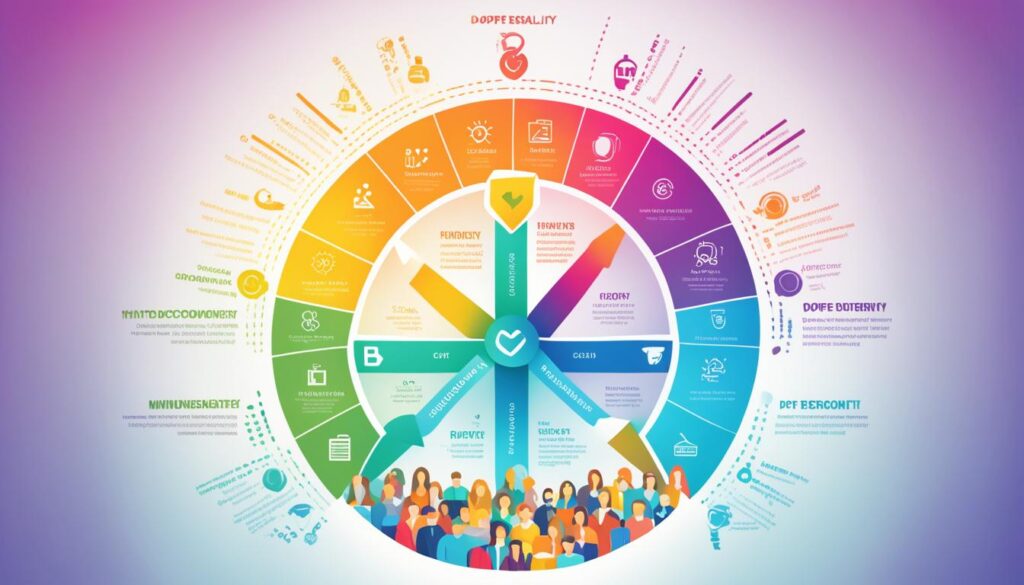
| Benefits of the DOPE Personality Test |
|---|
| Enhanced self-awareness |
| Improved communication |
| Improved interpersonal relationships |
| Alignment of actions and goals |
Applying the DOPE Personality Test in the Workplace
As managers, we can leverage the insights gained from the DOPE personality test to better understand our team members’ unique personalities and tailor our management approach accordingly. By recognizing each individual’s dominant bird type, we can create a work environment that fosters collaboration, supports individual growth, and maximizes team performance.
Understanding the different bird types represented in the DOPE test – Dove, Owl, Peacock, and Eagle – can provide us with valuable information about our team members’ strengths, communication styles, and work preferences. Armed with this knowledge, we can effectively assign tasks, build diverse teams, and create opportunities for personal and professional development.
One way to apply the DOPE personality test in the workplace is by assigning roles and responsibilities that align with each bird type’s characteristics. For example, Doves, known for their friendly and empathetic nature, may excel in customer service or positions that require a high level of teamwork. On the other hand, Owls, with their logical and analytical thinking, are well-suited for tasks that require attention to detail and problem-solving abilities.
Additionally, understanding the different bird types can help us navigate conflicts and improve team dynamics. By recognizing the innate tendencies and communication styles of each bird type, we can foster open dialogue, encourage empathy, and mediate conflicts more effectively. This knowledge allows us to create an inclusive and harmonious work environment where every team member feels valued and understood.
Table: Applying the DOPE Personality Test in the Workplace
Bird Type Characteristics Suitable Roles Dove Friendly, empathetic, team-oriented Customer service, teamwork-focused roles Owl Logical, detail-oriented, analytical Problem-solving, research, analytical roles Peacock Outgoing, creative, optimistic Marketing, sales, creative roles Eagle Confident, assertive, goal-oriented Leadership, sales, project management roles
By using the DOPE personality test as a tool for understanding and managing different personality types, we can foster a supportive and productive work environment. Embracing the unique strengths and preferences of each team member promotes individual growth, boosts team collaboration, and ultimately leads to enhanced overall performance.
Remember, the DOPE test is not about labeling individuals or putting them in boxes. It’s about understanding and appreciating the unique qualities each person brings to the team.
The DOPE Test as a Tool for Personal Growth
The DOPE test is not only a fascinating way to understand different personality types but also a powerful tool for personal growth and self-improvement. By delving into the depths of the DOPE test and understanding their dominant bird type, individuals can gain valuable insights into their own strengths, weaknesses, and areas for development.
Each bird type within the DOPE test represents a distinct set of characteristics and qualities. For example, Doves are known for their peaceful and friendly nature, while Owls bring wisdom and logical thinking to the table. Peacocks are all about bringing vibrant energy and creativity, and Eagles are natural-born leaders who thrive on challenges.
Knowing your bird type empowers you to focus on enhancing your strengths and working on the areas that need improvement. It provides a framework for self-reflection and guides you in your personal and professional journeys. Whether you want to strengthen your relationships, improve your communication skills, or enhance your decision-making abilities, the DOPE test can serve as a roadmap for personal growth.
By using the insights from the DOPE test, you can tailor your approach to different situations, adapt your communication style to connect better with others, and build harmonious relationships both in your personal and professional life.
Using the DOPE Test for Self-Improvement
Once you understand your dominant bird type, you can begin to explore ways to leverage your strengths and overcome your weaknesses. Here are a few strategies to help you use the DOPE test for self-improvement:
- Embrace your strengths: Identify your dominant bird’s unique qualities and find opportunities to apply them in your daily life. Whether it’s using your empathy and listening skills as a Dove or your analytical thinking as an Owl, embracing your strengths allows you to shine and achieve greater success.
- Challenge yourself: Step out of your comfort zone and take on tasks or roles that push you to grow. If you’re an Eagle, for example, seek out leadership opportunities that allow you to showcase your natural assertiveness and decision-making abilities.
- Develop new skills: Recognize the areas where you could benefit from improvement and actively work on developing new skills. If you’re a Peacock, for instance, focus on honing your organizational skills or learning to balance high energy with focused productivity.
- Seek feedback: Regularly seek feedback from trusted individuals to gain different perspectives on your strengths and areas for improvement. This feedback can provide valuable insights and help you refine your self-improvement efforts.
- Continuously learn and grow: Personal growth is an ongoing process. Stay curious, seek out new knowledge, and invest in personal development activities that align with your bird type. This could include reading self-help books, attending workshops, or even finding a mentor who can guide you on your journey of self-improvement.
Remember, the DOPE test serves as a starting point for self-improvement. It provides you with a better understanding of your personality and guides you toward maximizing your potential. By using the insights from the DOPE test and actively working on your personal growth, you can unlock new opportunities, build fulfilling relationships, and live a more authentic and purposeful life.

Conclusion
The DOPE personality test offers a unique and simplified approach to understanding different personality types. By identifying your dominant bird type, you can gain valuable insights into your own preferences and traits. This knowledge allows you to navigate your personal and professional relationships with greater understanding and empathy.
One key takeaway from the DOPE test is the importance of recognizing and appreciating the diversity of personality types. Each bird type brings its own strengths and perspectives to the table, and by embracing these differences, we can foster a more inclusive and collaborative work environment.
Furthermore, the DOPE test highlights the significance of effective communication. Understanding your bird type can help you tailor your communication style to better connect with others and avoid potential misunderstandings. This can lead to improved teamwork, enhanced productivity, and reduced conflicts.
In conclusion, the DOPE personality test provides valuable insights into individual preferences and behaviors. By leveraging this understanding, we can build stronger relationships, foster effective communication, and create a more harmonious and productive work environment.
The DOPE Personality Test is a unique and fun way to understand different personality types. It simplifies personalities into four types represented by birds: Dove, Owl, Peacock, and Eagle.
Doves are friendly and loyal individuals who excel in creating harmony and building strong relationships. They prefer calm and predictable environments and are great team players.
Owls are logical and methodical individuals who excel in analytical tasks. They have a strong attention to detail and are great problem solvers. Peacocks are vibrant and energetic individuals who thrive in social settings. They have highly developed interpersonal skills and enjoy being the center of attention.
Eagles are confident and goal-oriented individuals who enjoy taking on challenges. They are natural leaders who strive for results and are not afraid to take risks.
Doves represent friendly and loyal individuals, Owls represent logical and methodical individuals, Peacocks represent vibrant and energetic individuals, and Eagles represent confident and goal-oriented individuals.
By answering a series of questions, you can determine your dominant bird type and gain a deeper understanding of your strengths and potential areas for growth.
The DOPE test is based on the original four personality types developed by Dr. Gary Couture. It has evolved over time and incorporates insights from other personality tests and research studies. The DOPE test provides individuals with a better understanding of their personality, improves communication, enhances self-awareness, and helps improve interpersonal relationships.
Managers can use the insights from the DOPE test to understand their team members’ personalities and tailor their management approach accordingly. It helps create a work environment that promotes collaboration and individual growth.
By understanding your dominant bird type, you can identify areas for development and focus on enhancing your strengths. The test provides a framework for self-reflection and guides you in your personal and professional journeys.
FAQ
What is the DOPE Personality Test?
What are the characteristics of a Dove?
What are the characteristics of an Owl?
What are the characteristics of a Peacock?
What are the characteristics of an Eagle?
What does each bird represent in the DOPE test?
How do I take the DOPE Personality Test?
What is the history of the DOPE Personality Test?
What are the benefits of the DOPE Personality Test?
How can the DOPE Test be applied in the workplace?
How can the DOPE Personality Test help with personal growth?
Eugene brings a fresh, dynamic voice to our platform as one of our talented Writers. Specializing in research-driven content, he explores the latest findings in psychology and personal growth, translating them into actionable insights for our readers. Eugene’s work is fueled by a curiosity about what makes us tick and a desire to help others unlock their potential.
The Big Five (OCEAN)
What Is the Tax Assessment for 1320 Vina Ave Ocean Nj?
Tantalizingly close to uncovering the tax assessment for 1320 Vina Ave in Ocean, NJ, embark on a journey to unravel the intricate factors shaping property evaluations.

As we approach the virtual entrance of 1320 Vina Ave in Ocean, NJ, the question hangs in the air: what is the tax assessment for this property?
While the specifics may not be immediately apparent, the intricate web of factors that influence tax assessments holds the key to unraveling this mystery.
Join us as we explore the nuances of property tax assessments, shedding light on the importance of accurate evaluations and the potential implications for homeowners.
Key Takeaways
- The tax assessment for 1320 Vina Ave, Ocean, NJ is crucial for determining property tax obligations.
- Property characteristics, location, and market conditions influence the tax assessment.
- Accuracy in assessment ensures fair taxation and equitable distribution of tax burden.
- Homeowners can appeal the assessment if they believe it is inaccurate, potentially reducing property taxes.
Understanding Property Tax Assessments
When assessing property taxes, we consider various factors that impact the value of a property in order to determine the tax owed to the local government. In the case of 1320 Vina Ave in Ocean, NJ, the tax assessment hinges on the property's value as determined by the local tax assessor. This valuation plays a crucial role in calculating how much the property owner will need to pay in taxes to the local government.
Factors such as the size of the property, its location, any improvements made, and comparable sales in the area are all taken into account during the assessment process. By analyzing these elements, the tax assessor aims to distribute the tax burden among property owners fairly and accurately.
It's vital to comprehend that changes in property tax assessments can significantly impact the annual tax obligations of a property owner, making it imperative to stay informed about the assessment process and one's property rights reserved.
Factors Influencing Tax Assessment

Factors influencing tax assessment include the property's characteristics, market conditions, and any recent changes in property value. The size, location, amenities, and recent sales of comparable properties all play a crucial role in determining the tax assessment value. Property improvements, renovations, and fluctuations in the real estate market can also impact the assessment. Additionally, the tax assessment is essential for calculating property taxes owed to the local government. Property owners should be aware that they have the right to appeal the assessment if they believe it is inaccurate. Below is a table summarizing the key factors that influence tax assessment:
| Factors Influencing Tax Assessment |
|---|
| Property Characteristics |
| Market Conditions |
| Recent Changes in Property Value |
Importance of Accurate Assessments
Accurate assessments play a pivotal role in ensuring fair and equitable property tax obligations for homeowners in Ocean, NJ.
- Fair Taxation: Accurate assessments help distribute the tax burden fairly among property owners based on the actual value of their properties.
- Equity: Ensuring accuracy in assessments prevents disparities where some homeowners may be unfairly taxed more or less than others.
- Budget Planning: Property tax revenues are a significant source of income for local governments, and accurate assessments are essential for proper budget planning and allocation of resources.
- Community Development: Properly assessed property taxes contribute to the funding of essential services like schools, infrastructure, and public safety, fostering community development.
Appeals Process for Tax Assessments

Initiating an appeal for a tax assessment involves submitting a formal written request to the local tax assessor's office. Property owners who believe their tax assessment is inaccurate or unfair can follow this process.
The appeal typically requires the submission of evidence supporting the property owner's claim, such as recent comparable property sales or a professional appraisal. This evidence is crucial in demonstrating why the current assessment may not align with the property's actual market value.
The outcome of a tax assessment appeal can lead to a revision of the property's assessed value, potentially resulting in lower property taxes for the owner. It's essential for property owners to carefully review their assessment and consider appealing if they've valid reasons to believe it's incorrect.
Impact of Tax Assessments on Homeowners
Given the potential financial implications of tax assessments on homeowners, understanding how these assessments impact property taxes and overall housing costs is crucial.
- Tax assessments directly influence property taxes, with higher assessments often resulting in increased tax burdens for homeowners.
- The assessment for a property like 1320 Vina Ave can play a significant role in determining its resale value, as it reflects the local government's valuation of the property.
- Homeowners have the option to appeal tax assessments if they believe the assessed value doesn't align with the actual market value of their property.
- Being knowledgeable about tax assessments is essential for homeowners to effectively manage their financial responsibilities and plan their budgets accordingly.
Considering these factors, homeowners must stay informed about tax assessments to make informed decisions regarding their property investments and financial well-being.
Frequently Asked Questions
How Do Property Tax Assessments Differ for Residential and Commercial Properties?
When comparing property tax assessments for residential and commercial properties, it's essential to note the differing evaluation methods. Residential properties are typically assessed based on their market value and comparable sales in the area, while commercial properties may also consider the income generated or cost to replace the property.
This variation reflects the distinct purposes and characteristics of these property types, impacting how tax assessments are calculated and adjusted.
Are There Any Exemptions or Deductions Available for Property Tax Assessments in Ocean, Nj?
In Ocean, NJ, there are exemptions and deductions available for property tax assessments. These can provide relief for certain homeowners, such as seniors or disabled individuals, easing the financial burden of property ownership.
Understanding these options is crucial for maximizing savings and ensuring fair taxation. By exploring these exemptions and deductions, homeowners can navigate the complexities of property tax assessments with confidence and peace of mind.
Can Property Owners Request a Reassessment of Their Tax Assessment Outside of the Formal Appeals Process?
Yes, property owners can request a reassessment of their tax assessment outside of the formal appeals process. This option allows for a proactive approach to potentially lower property taxes.
How Do Tax Assessments Affect the Resale Value of a Property in Ocean, Nj?
When considering how tax assessments impact property resale value in Ocean, NJ, it's crucial to recognize the direct correlation between assessment amounts and potential buyer perception.
Higher tax assessments can deter buyers seeking affordability, while lower assessments may attract budget-conscious buyers.
These assessments serve as a key factor in determining a property's overall market appeal and can significantly influence its resale value.
Are There Any Community Initiatives or Programs in Ocean, NJ Aimed at Helping Homeowners Understand and Manage Their Tax Assessments?
There are community initiatives and programs in Ocean, NJ aimed at helping homeowners understand and manage their tax assessments. These programs often provide workshops, resources, and guidance to navigate the complexities of tax assessments.
By participating in these initiatives, homeowners can gain valuable insights into how tax assessments impact their property values and learn strategies to potentially lower their tax burden.
How Can I Determine the Tax Assessment for a Property in Ocean, NJ?
To determine the tax assessment for a property in Ocean, NJ, follow these effective ocean assessment steps. First, gather property details from the local assessor’s office. Next, review recent sales of similar properties in the area. Then, compare the assessed value to the market value. Finally, consider appealing the assessment if needed.
Conclusion
In conclusion, accurate property tax assessments are crucial for homeowners as they directly impact the amount of taxes they pay.
One interesting statistic to note is that the tax assessment for 1320 Vina Ave, Ocean, NJ 07712 isn't provided, but the property's Zestimate has increased by $19,472 (2.7%) in the past 30 days.
This highlights the fluctuating nature of property values and the importance of staying informed about tax assessments.
Eugene brings a fresh, dynamic voice to our platform as one of our talented Writers. Specializing in research-driven content, he explores the latest findings in psychology and personal growth, translating them into actionable insights for our readers. Eugene’s work is fueled by a curiosity about what makes us tick and a desire to help others unlock their potential.
The Big Five (OCEAN)
Ocean Assessment Framework: A Step-by-Step Guide
Keen to unlock the secrets of sustainable ocean management? Dive into the Ocean Assessment Framework for a transformative journey towards marine conservation.
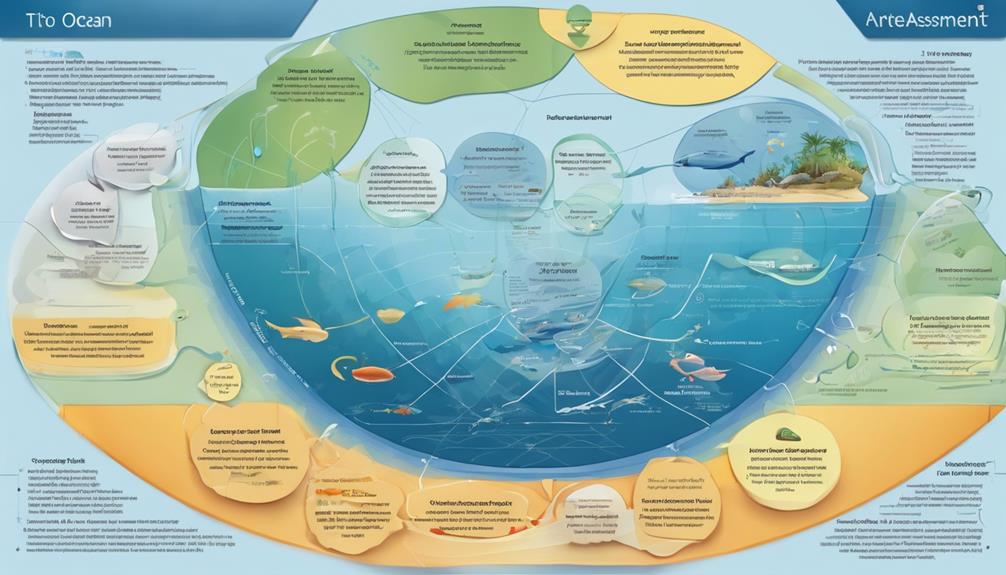
As we explore the extensive waters of our oceans, it is important to recognize that only a mere 7% of the world’s oceans are currently protected. With such a small percentage safeguarded, our comprehension and care for marine environments become essential.
The Ocean Assessment Framework offers a structured path towards sustainable ecosystem management, but what exactly makes this guide a pivotal tool in the realm of marine conservation?
Let's explore the intricate steps laid out within this framework and uncover how it can shape the future of our oceans.
Key Takeaways
- Assess biodiversity, habitat quality, and water conditions for marine ecosystem health
- Utilize data analysis tools to monitor ocean parameters and trends effectively
- Implement conservation measures like Marine Protected Areas and sustainable practices
- Promote respectful behavior towards oceans and support initiatives for marine ecosystem conservation
Importance of Ocean Assessment Framework
The Ocean Assessment Framework stands as an indispensable tool in our efforts to assess the health and sustainability of marine ecosystems. This structured approach allows us to comprehensively understand the impacts of human activities on oceans, paving the way for informed decision-making.
By providing a systematic method for monitoring marine resources, the framework enables us to implement conservation measures effectively. Through assessing oceans using this framework, we can pinpoint key areas requiring intervention and management, thus directing resources where they're most needed.
This process is vital in promoting sustainable practices and safeguarding marine biodiversity, ensuring the long-term health of our oceans. In essence, the Ocean Assessment Framework serves as a beacon guiding our conservation efforts, offering a pathway towards a future where marine ecosystems thrive in harmony with human activities.
Key Indicators for Marine Ecosystems
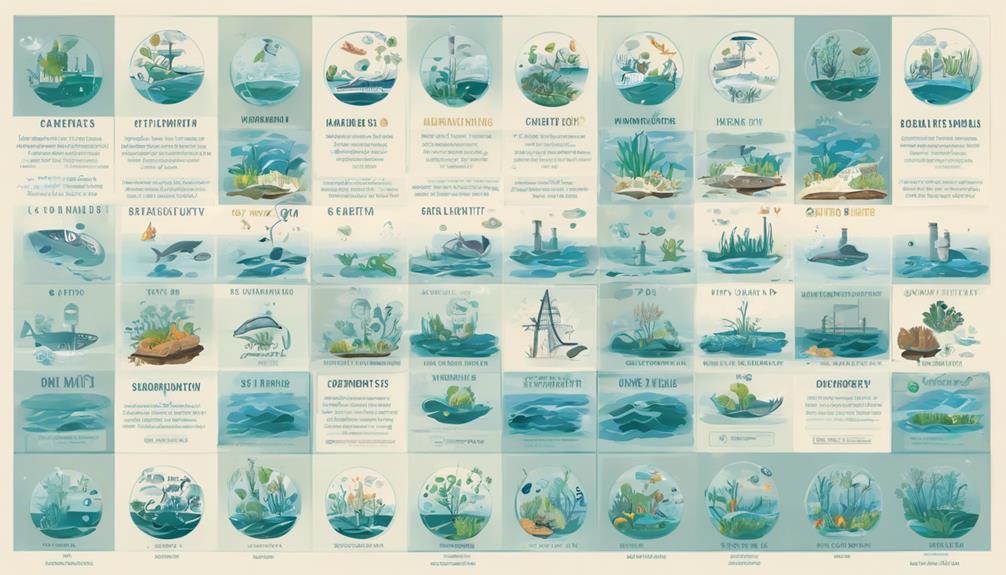
Assessing the health of marine ecosystems involves closely monitoring key indicators such as biodiversity levels, habitat quality, water quality, and population trends of key species. These indicators provide valuable insights into the overall well-being of marine environments. For instance, changes in coral reef health, seagrass coverage, and mangrove distribution are crucial factors that reflect the ecological balance within these ecosystems. Additionally, tracking nutrient levels, presence of pollutants, and ocean acidification levels are essential for understanding the impact of human activities on marine environments.
Population dynamics of fish stocks, migratory patterns of marine species, and changes in sea surface temperature serve as critical indicators for assessing the resilience of marine ecosystems to environmental stressors. Furthermore, monitoring the extent of marine protected areas, presence of invasive species, and trends in marine pollution play a vital role in evaluating the effectiveness of conservation efforts aimed at preserving marine biodiversity. By focusing on these key indicators, scientists and policymakers can make informed decisions to safeguard the health of our oceans for future generations.
Data Analysis for Ocean Assessment
Monitoring and analyzing data on various ocean parameters, such as temperature, salinity, pH, and biodiversity, is essential for comprehensive ocean assessment. Scientists employ advanced tools like satellites, buoys, and research vessels to gather data, which is then subjected to statistical methods and modeling techniques for interpretation.
This data analysis reveals crucial trends, patterns, and anomalies within the ocean ecosystem, providing valuable insights for effective management and conservation strategies. By integrating data analysis into ocean assessment, policymakers, researchers, and conservationists can make informed decisions to promote sustainable ocean management.
The use of sophisticated analytical approaches not only aids in understanding the current state of the oceans but also enables the prediction of future scenarios, facilitating proactive conservation measures. Through meticulous data analysis, we can delve deeper into the intricate workings of the marine environment and work towards preserving its delicate balance for future generations.
Implementing Conservation Measures
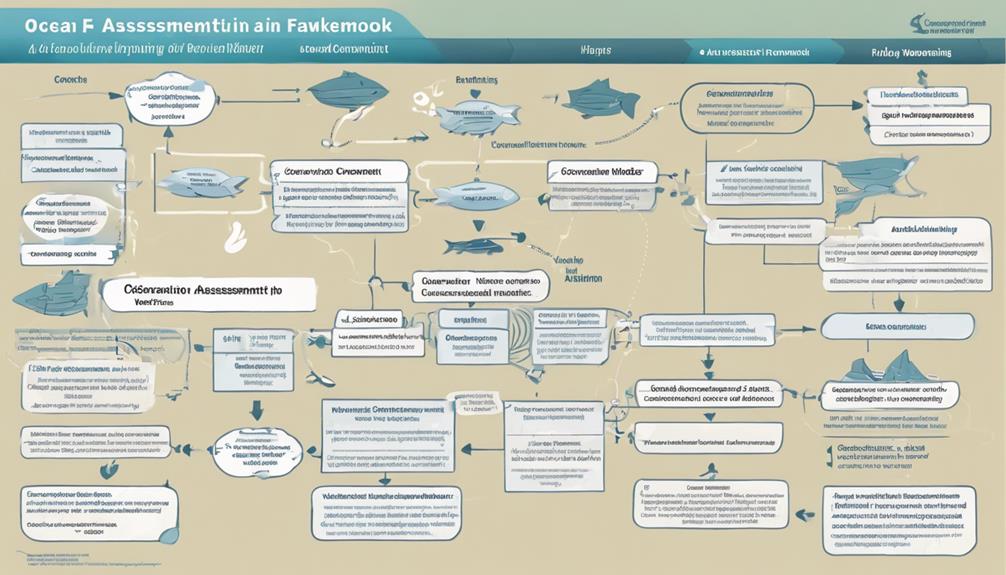
To enhance the preservation of marine ecosystems, a comprehensive approach integrating various conservation measures is essential. When implementing conservation measures, we must consider the interconnectedness of marine life and the delicate balance of the ocean environment. Here are key steps to effectively implement conservation measures:
- Establish Marine Protected Areas: Creating designated zones helps protect biodiversity and critical habitats from human activities such as overfishing and habitat destruction.
- Reduce Threats: Conservation measures focus on mitigating threats like overfishing and pollution that endanger marine species and disrupt the marine ecosystem's equilibrium.
- Promote Sustainable Practices: Encouraging sustainable fishing practices and reducing pollution ensures the long-term health and resilience of marine resources for future generations.
Making a Positive Impact on Oceans
Promoting sustainable practices in ocean conservation is key to making a positive impact on marine ecosystems. By implementing marine spatial planning, we can effectively manage human activities in oceans, reducing harmful impacts on marine life.
Following an ecosystem-based management approach is crucial for the conservation of marine ecosystems, ensuring a balanced and healthy ocean environment. Sustainable practices in utilizing marine resources are essential for the long-term health of our oceans, preventing overexploitation and depletion of vital species.
Integrating environmental concerns into planning processes is fundamental for sustainable ocean management, fostering a holistic approach that considers the interconnectedness of marine systems. Initiatives like Respectzone play a significant role in promoting respectful behavior towards the oceans, encouraging responsible actions that contribute to conservation efforts.
Frequently Asked Questions
What Is the Big 5 Framework Ocean?
We've got you covered!
The Big 5 framework, also known as OCEAN, delves into personality traits like Openness, Conscientiousness, Extroversion, Agreeableness, and Neuroticism. It offers valuable insights into behaviors, work preferences, and values of individuals.
Widely used in psychology and recruitment, the Big 5 model helps in making informed hiring decisions and fostering effective team dynamics. It's a powerful tool for understanding people and optimizing workplace interactions.
What Is the OCEAN 5 Factor Model?
Sure, the OCEAN 5 Factor Model categorizes personality traits into Openness, Conscientiousness, Extroversion, Agreeableness, and Neuroticism.
It's a tool for understanding behavior, values, and work preferences.
Widely used in psychology and recruitment, OCEAN aids in making informed hiring decisions and matching candidates to suitable roles.
Understanding this model enhances recruitment accuracy, contributing to building effective teams.
What Are the 5 Main Components of Personality Represented by the Ocean Model Discussed in Chapter 12?
We find the Ocean model in Chapter 12 detailing 5 key personality components:
- Openness, which measures receptiveness to new experiences and creativity.
- Conscientiousness, covering traits like organization and dependability.
- Extroversion, gauging energy levels around others.
- Agreeableness, assessing interpersonal harmony and pro-social behaviors.
- Neuroticism, which evaluates emotional stability.
These elements collectively provide a comprehensive view of an individual's personality traits.
What Are the Five Letters of Ocean Model?
The five letters of the OCEAN model are Openness, Conscientiousness, Extroversion, Agreeableness, and Neuroticism. These letters represent crucial personality traits that provide deep insights into individual behaviors and workplace dynamics.
Understanding each trait helps in comprehending how individuals interact, handle stress, and approach tasks. Employing the OCEAN model can greatly enhance team building efforts and improve strategies for managing employees effectively.
What Are the Key Steps in Using the Ocean Assessment Framework for Marine Research?
When conducting marine research, utilizing ocean assessment tools is crucial. The key steps in using the Ocean Assessment Framework for marine research involve collecting relevant data, analyzing the information, and interpreting the findings to gain insights into the health and quality of the marine environment.
Conclusion
In conclusion, the Ocean Assessment Framework offers a systematic approach to managing marine ecosystems, ensuring their sustainability and health. By utilizing key indicators and data analysis, we can implement conservation measures that make a positive impact on oceans.
How can we continue to protect and preserve our marine resources for future generations to enjoy?
Eugene brings a fresh, dynamic voice to our platform as one of our talented Writers. Specializing in research-driven content, he explores the latest findings in psychology and personal growth, translating them into actionable insights for our readers. Eugene’s work is fueled by a curiosity about what makes us tick and a desire to help others unlock their potential.
The Big Five (OCEAN)
Top 3 Ocean Assessment Tools for Marine Researchers
Wade into the depths of marine research with the top three ocean assessment tools that are revolutionizing how we explore and conserve our oceans.
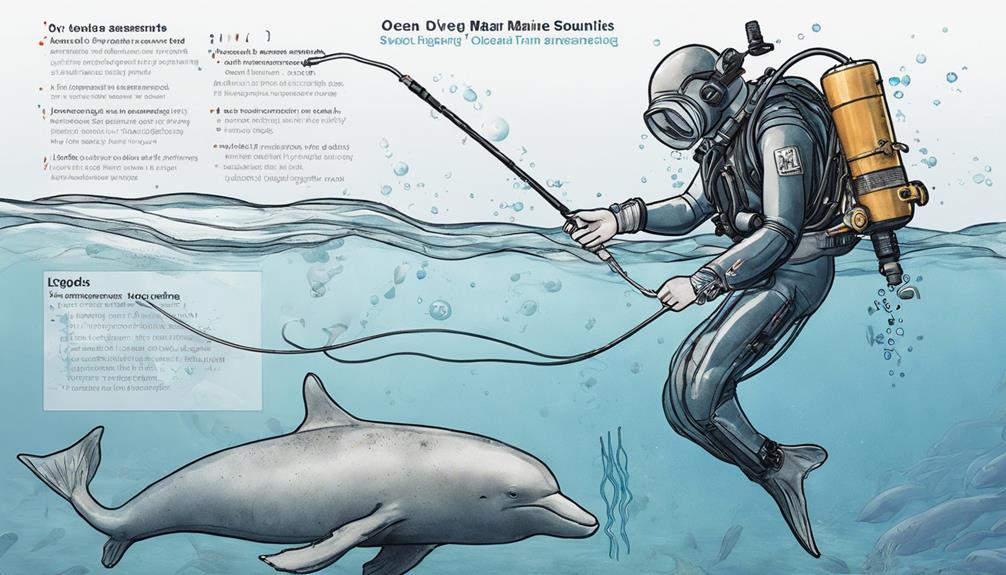
We have all faced the daunting challenge of choosing the best ocean assessment tools for our research projects. But have no fear, as we explore the wide array of options to identify the top three essential tools for marine researchers.
These tools are not only essential but also groundbreaking in their capabilities to unravel the mysteries of the ocean depths. So, which tools made the cut and why are they indispensable assets for those exploring the marine realm?
Stay tuned to discover the key players shaping the future of oceanic research and conservation.
Key Takeaways
- Underwater Drones (ROVs) aid in high-resolution ocean floor mapping and provide access to deep ocean environments.
- Acoustic technology efficiently covers large areas in surveys, helping in tracking fish populations and assessing biodiversity.
- Satellite imaging offers real-time data on ocean parameters, supporting global conservation efforts and monitoring climate change impacts.
- Data analysis tools provide insights into marine ecosystem health, aiding in sustainable management of ocean resources and guiding conservation efforts.
Underwater Drones for Ocean Mapping
Underwater drones, also known as Remotely Operated Vehicles (ROVs), play a crucial role in high-resolution ocean floor mapping for marine researchers. Equipped with cameras, sensors, and sampling devices, these drones allow us to explore the depths of the ocean where human divers can't reach.
The ability to operate at great depths provides us with access to a world teeming with diverse marine organisms and unique ecosystems. ROVs enable us to study the water column, collect samples, and analyze the distribution of species in their natural habitat.
Satellite Imaging for Ocean Monitoring

Satellite imaging plays a pivotal role in ocean monitoring by providing real-time data on essential parameters such as ocean surface temperature, chlorophyll concentration, and sea level height. These images help monitor ocean currents, detect phytoplankton blooms, and track changes in sea ice extent. The table below illustrates some of the key aspects of satellite imaging for ocean monitoring:
| Parameters | Information Provided | Application |
|---|---|---|
| Ocean Surface Temperature | Helps track variations in temperature, aiding in the prediction of weather events. | Monitoring climate change impacts. |
| Chlorophyll Concentration | Indicates levels of phytoplankton, crucial for understanding marine ecosystems. | Detecting phytoplankton blooms. |
| Sea Level Height | Assists in studying sea level rise and ocean circulation patterns. | Monitoring coastal erosion and storm surges. |
Satellite data aids in understanding ocean circulation patterns, identifying marine pollution, and predicting weather events. Researchers utilize satellite imaging to study coral reef health, monitor coastal erosion, and assess the impact of climate change on oceans. The continuous monitoring capabilities of satellite imaging support global efforts in ocean conservation and management.
Acoustic Technology for Marine Surveys
Utilizing acoustic technology, marine researchers employ sound waves to map the seafloor and detect marine organisms in comprehensive surveys. Acoustic surveys play a vital role in studying marine habitats, tracking fish populations, and assessing biodiversity in underwater environments.
Here are four key aspects of how acoustic technology enhances marine surveys:
- Efficient Coverage: Acoustic surveys can efficiently cover large areas, providing researchers with extensive data on marine ecosystems and their overall health.
- Species Identification: By analyzing acoustic data, scientists can identify species distributions, migratory patterns, and even detect underwater structures essential for marine life.
- Conservation Guidance: Acoustic technology is crucial for understanding marine environments, guiding conservation efforts, and promoting sustainable management of ocean resources.
- Ecosystem Health: Acoustic surveys help researchers monitor the health of marine ecosystems, offering valuable insights for preserving these vital habitats.
Frequently Asked Questions
What Are 3 Tools Oceanographers Use?
We use Conductivity-Temperature-Depth (CTD) profilers to measure properties like salinity, temperature, and depth.
Environmental sensors on collecting nets help us gather data on marine organisms.
Satellite data provides crucial real-time information for monitoring.
CTD rosettes collect water samples at various depths.
Remotely Operated Vehicles (ROVs) are essential for exploring ocean depths.
These tools help us study marine environments more effectively and understand ocean processes better.
What Are the 3 Technologies for Studying the Ocean Floor?
When studying the ocean floor, researchers rely on multibeam bathymetric systems for detailed seafloor mapping. Sonar and seismic profiling technologies provide geological insights, while acoustic systems are used for biomass estimation.
These tools collectively offer a comprehensive understanding of oceanic structures, processes, and marine life. By combining these technologies, marine researchers gain valuable data to further our knowledge of the underwater world.
What Are Some Tools Marine Scientists Use to Study the Ocean?
We utilize various tools to study the ocean, including CTD profilers for measuring physical data, multibeam bathymetric systems to map seafloor topography, and acoustic systems for estimating biomass.
Water sampling devices like the CTD/rosette system help gather data for chemical analysis.
Remotely Operated Vehicles (ROVs) allow us to explore ocean depths and conduct research in challenging environments.
These tools provide valuable insights into marine ecosystems and ocean properties.
Which Tool Would a Scientist Use to Study Ocean Currents?
We'd use Acoustic Doppler Current Profilers (ADCPs) to study ocean currents. These instruments measure water velocities at different depths non-intrusively using Doppler technology. ADCPs can be mounted on moorings, boats, or autonomous underwater vehicles for continuous monitoring.
The data they provide is crucial for understanding ocean circulation dynamics and their impact on climate systems. By creating models and forecasts based on ADCP data, we can advance various marine research studies effectively.
How are the Ocean Assessment Tools for Marine Researchers Different from the Global Marine Assessment?
Ocean assessment tools for marine researchers focus on local and specific data collection, analysis, and monitoring of marine environments. In contrast, the global marine assessment provides insights into the overall health and condition of the world ocean, considering a broader perspective on the state of marine ecosystems and resources.
Conclusion
In conclusion, the top 3 ocean assessment tools for marine researchers provide invaluable insights into the health and dynamics of our oceans.
Underwater drones, satellite imaging, and acoustic technology offer precise data for mapping, monitoring, and surveying marine environments.
Their combined capabilities create a comprehensive understanding of ocean ecosystems, aiding in conservation efforts.
The use of these advanced tools enhances our ability to protect and preserve our precious marine resources.
Eugene brings a fresh, dynamic voice to our platform as one of our talented Writers. Specializing in research-driven content, he explores the latest findings in psychology and personal growth, translating them into actionable insights for our readers. Eugene’s work is fueled by a curiosity about what makes us tick and a desire to help others unlock their potential.
-

 Self-Understanding3 months ago
Self-Understanding3 months agoUnderstanding DMCA Protections & Compliance
-

 Relationship Dynamics3 months ago
Relationship Dynamics3 months agoCan a Man Truly Love His Side Chick
-

 Enneagram of Personality1 week ago
Enneagram of Personality1 week agoEnneagram Test: Printable Version for Easy Self-Discovery
-

 Personality Exploration3 weeks ago
Personality Exploration3 weeks agoDiscover Your Traits with Atomic Habits Personality Test
-
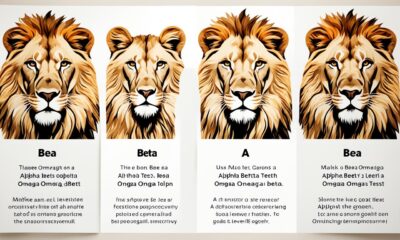
 Personality Exploration2 weeks ago
Personality Exploration2 weeks agoAlpha Beta Omega Personality Test Explained
-

 Personality Exploration3 months ago
Personality Exploration3 months agoAlpha Beta Omega Sigma Female Personality Quiz
-

 Self-Understanding2 months ago
Self-Understanding2 months agoDiscover Your Traits with Our Personality Test
-

 Personality Exploration3 months ago
Personality Exploration3 months agoUnderstanding Personality Tests | Our Guide Explained
